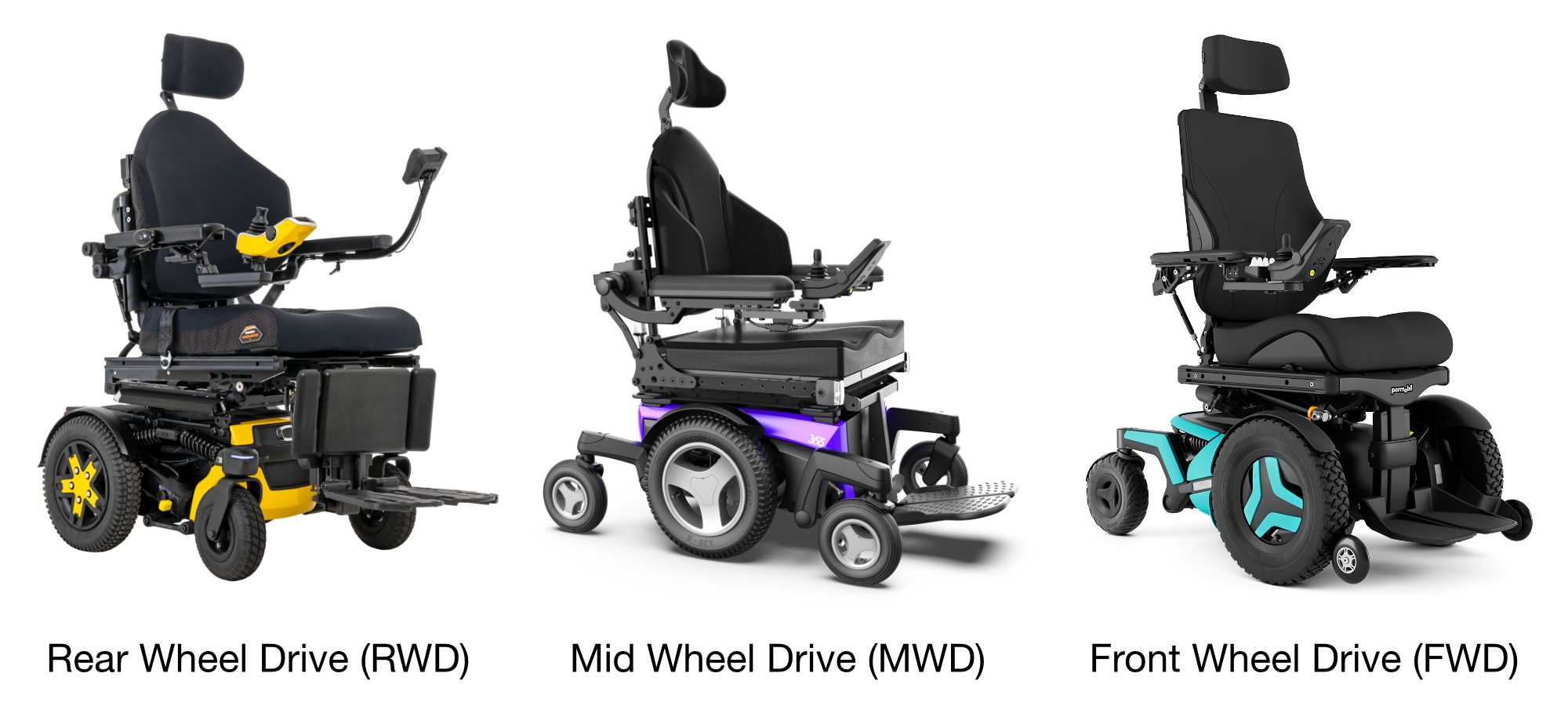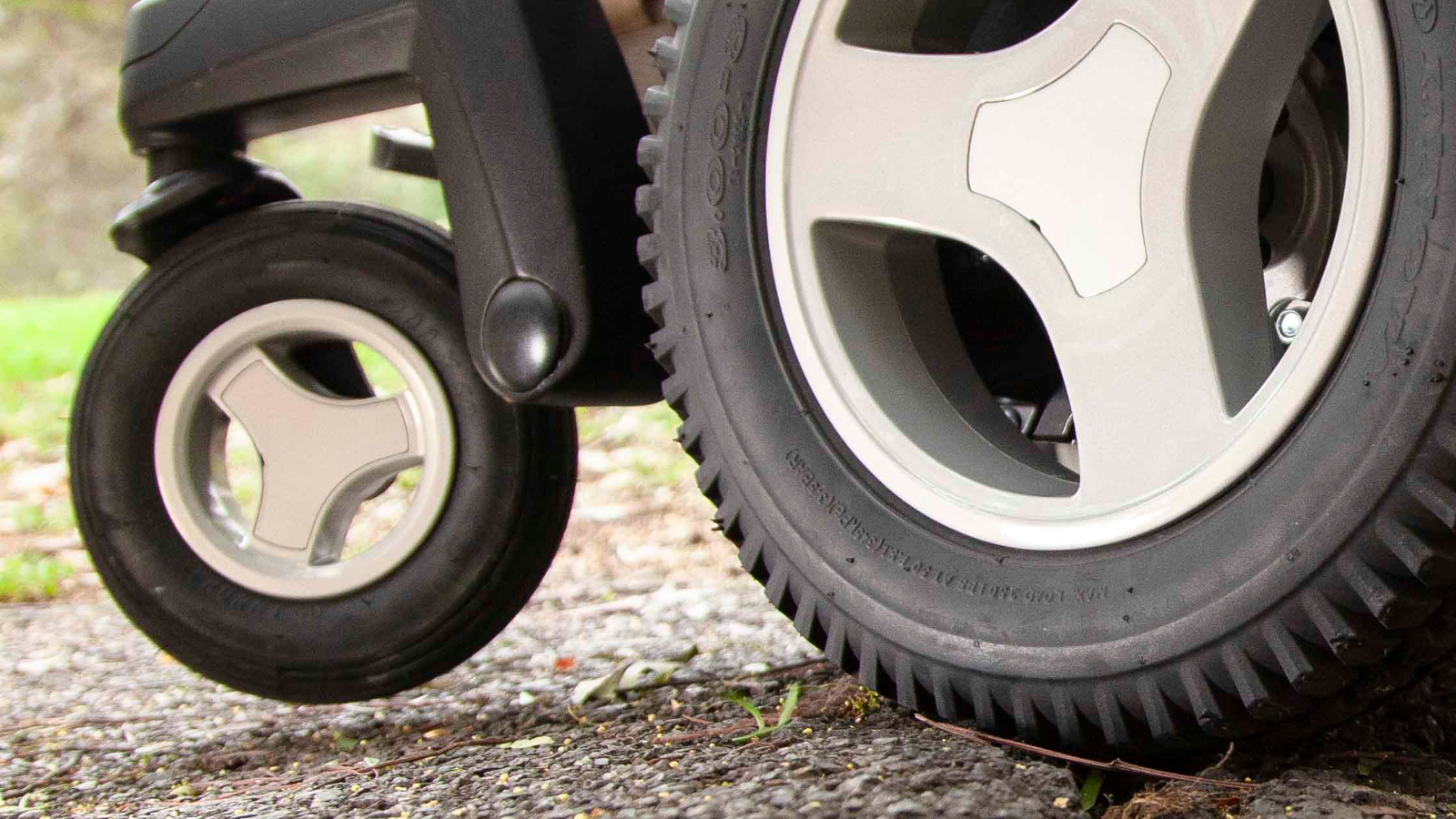
One of the most significant considerations when selecting the right power wheelchair is the drive wheel position. The drive wheel, which is the larger wheel when viewing the wheelchair, holds considerable influence over the wheelchair's driving dynamics, its ability to surmount obstacles, and its agility across varying settings.
The drive wheel location is described in relation to the user’s centre of gravity. A rear-wheel drive power wheelchair (RWD) positions the user’s centre of gravity ahead of the drive wheel. A mid-wheel drive power wheelchair (MWD) has the user’s centre of gravity somewhere over the drive wheel. A front-wheel drive power wheelchair (FWD) has the user’s centre of gravity well behind the drive wheel.

Each drive wheel option comes with its own set of advantages and considerations, so let's explore how drive wheel position impacts on a wheelchair’s manoeuvrability, performance and stability.
Rear-Wheel Drive (RWD)
RWD power wheelchairs are characterised by their stability, making them a popular choice for outdoor use. The drive wheels are located at the back, providing a sense of control, especially on rough terrain. This configuration also offers a natural driving feel similar to that of traditional rear-wheel drive vehicles where the pivot point when turning is at the rear of the wheelchair. Here are some points to consider when opting for an RWD power wheelchair:
Advantages:
- Stability: RWD chairs offer excellent stability, making them suitable for navigating uneven surfaces and outdoor terrains.
- Efficiency: The design allows for powerful torque, making them capable of tackling inclines and hills with ease.
Considerations:
- Turning Radius: RWD chairs may have a wider turning radius, which could be a limitation in confined spaces or tight corners.
- Manoeuvrability: While advancements in design have improved manoeuvrability, RWD chairs might not be as agile as other configurations, especially in tight spaces.
Mid-Wheel Drive (MWD)
The MWD is the most recently developed drive wheel position, designed to combine the favourable attributes of both front-wheel and rear-wheel drive to offer the best of both worlds. MWD power wheelchairs strike a balance between stability and manoeuvrability. The drive wheels are positioned beneath the user, offering a tight turning radius and enhanced indoor navigation capabilities.
This drive wheel arrangement proves highly effective for individuals new to using power wheelchairs as many people find them intuitive to learn to control. The turning point, or axis of rotation, generally aligns with the body's midline, mirroring the natural walking motion. Consequently, when manoeuvring a mid wheel drive (MWD) wheelchair around a corner, the turning process initiates as your body reaches the corner of a wall, akin to the beginning of a turn while walking.
Advantages:
- Turning Radius: MWD chairs shine in confined spaces. It has the smallest 360 ̊ turning radius of the three drive wheel configurations which can improve manoeuvrability for many individuals in their home or smaller spaces. Their ability to turn on the spot makes them a go-to choice for indoor use.
- Precise Manoeuvrability: The centre-wheel position provides a steady, controlled experience, enhancing overall manoeuvrability.
- Stability: With six wheels in contact with the ground, a mid-wheel drive wheelchair ensures exceptional stability. This holds true when navigating inclines, ramps, or both ascents and descents.
Considerations:
- Outdoor Performance: While MWD chairs perform well indoors, their stability on uneven outdoor terrain might not match that of RWD chairs.
- Bumpy ride: Having six ground-contacting wheels results in a greater transfer of energy from the terrain to the user. For instance, when encountering a bump, the sensation of that bump could be experienced three times due to the six wheels, as opposed to the two instances in a RWD or FWD configuration. This has the potential to somewhat compromise the comfort of the ride for the wheelchair occupant. Fortunately, various manufacturers offer suspension systems that can effectively mitigate the impact of this.
- Traction: One of the main reasons MWD chairs aren’t as great in outdoor environments is the potential for “high centring”. This term is used to describe when the drive wheels lose traction and may not be able to move in certain situations. We usually see this happen with rolled gutters, where the front castors climb the gutter, the rear castors remain contacting the ground, the drive wheels lose traction and the wheelchair cannot climb the gutter. Many manufacturers now have technologies and suspension that can compensate for this which has greatly decreased the risk of this occurring. If considering a MWD wheelchair, it is important to trial the wheelchair in the outdoor environment it will be used in, especially if the area has rolled gutters.
Front-Wheel Drive (FWD)
The FWD power wheelchair is a great choice for getting around indoors, and it's also well suited for outdoor adventures. The bigger drive wheel leads the way, tackling uneven surfaces before the smaller casters. Because the front wheels are hooked up to the drive motors, they help pull the casters over obstacles and through all sorts of terrain – a big difference from when the casters are in the front and have to climb the obstacle first.
Advantages:
- Manoeuvrability: FWD chairs excel in manoeuvring tight corners and indoor spaces, thanks to their compact turning radius. This configuration results in a tighter turning radius, which means the wheelchair can make sharper turns and navigate through narrow passages with ease. Although a FWD wheelchair does have a turning radius that is not as compact as that of a MWD in terms of a 360° turn, its smaller front turning aspect could be more frequently employed than the need to make a complete circular turn.
- Getting close to items: Typically, a FWD wheelchair facilitates a closer approach to objects, such as a bathroom sink. The strategic positioning of the drive wheel at the front end enables the wheelchair to pivot around it effectively. This pivot capability empowers the wheelchair to manoeuvre in close proximity to items, ensuring optimal accessibility and interaction. FWD can be making an ideal choice for situations where getting closer to items is essential.
- Obstacle Clearance: The front-wheel drive design enables better clearance over obstacles like curbs. Any wheelchair can only climb over obstacles that are small enough for the drive wheel to climb over. The space between the axle (the centre of the wheel or caster) and the ground is important to consider when thinking about obstacles. If an obstacle is larger than this space, the chair won't be able to pass over it. So, when you're moving forward over an obstacle, the front-wheel drive has a clear advantage due to the larger size of the wheel. The total diameter of the drive wheel in a front-wheel drive is 14", while the caster wheel in a MWD or RWD is generally 7” with some wheelchairs having 9”-10” castors. This means the obstacle you can potentially overcome in a FWD is larger compared to a MWD or RWD.
- Traction: FWD wheelchairs often excel on inclined surfaces and offer good traction.
Considerations:
- Stability: FWD chairs may exhibit slightly less stability compared to RWD chairs, particularly on uneven terrain.
- Outdoor Performance: While FWD chairs can most handle outdoor terrain that is thrown at it, a RWD wheelchair will handle challenging terrain better.
- Turning Radius: FWD chairs might have a larger turning radius compared to mid-wheel drive options in regards to 360° turns (e.g. turning around in a lift)
- Manoeuvrability: While not as nimble as mid-wheel drive chairs indoors, FWD chairs can still navigate reasonably well in indoor spaces.
- Learning curve: a FWD wheelchair handles a little like a forklift with the axis of rotation at the front of the wheelchair. It generally isn’t as intuitive to learn to control as a MWD or RWD, however most people can learn quickly with the right tips and practice.
GTK supplies the Permobil, Magic Mobility, Quantum and Ottobock range of powered wheelchairs. Our extensive range allows us to find a suitable solution for powered mobility needs. For further information on the range please get in contact with us and one of our friendly Assistive Technology Consultants will be able to help.



